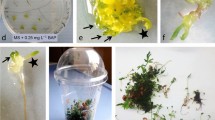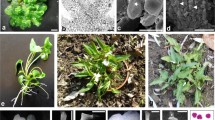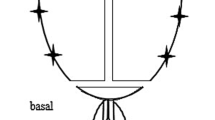Abstract
Eriophorum vaginatum L. is a promising species for phytostabilization, restoration, or creation of wetlands, because it can survive in cold, nutrient-poor, or metal-contaminated soils. However, its propagation on a large scale is problematic due to the infrequent production of viable seeds, seed dormancy, and the limitations of reproduction by rhizomes. A technique to rapidly and effectively produce large quantities of outplanting stock of this species was sought. Seeds of E. vaginatum were cultured on Murashige and Skoog (MS) medium supplemented with plant growth regulators at different concentrations. The highest regeneration rate was obtained on MS medium supplemented with 2.26 μM 2,4-dichlorophenoxyacetic acid (2,4-D) and 2.32 μM kinetin (KIN) for callus induction, and 17.76 μM BA (6-benzylaminopurine) for shoot regeneration as well as when 2.26 μM 2,4-D and 4.65 μM KIN was added to the callus-induction medium, and 8.88 μM or 17.76 μM BA to the shoot-regeneration medium. The regenerated shoots were rooted on MS medium without growth regulators and acclimatized in a greenhouse. Genetic stability of the in vitro regenerants was determined using flow cytometry and random amplified polymorphic DNA. Cytometric analysis revealed that the nuclear DNA content was similar in all plant materials and amounted to about 0.8 pg/2C. The PCR amplification products were monomorphic in callus-derived plants and similar to plants grown in a field. Lack of genome size variation and polymorphism within the regenerants indicates that the detailed E. vaginatum micropropagation protocol allows the production of a large number of genetically stable plants.



Similar content being viewed by others
Abbreviations
- 2,4-D:
-
2,4-Dichlorophenoxyacetic acid
- BA:
-
6-Benzylaminopurine
- IAA:
-
Indole-3-acetic acid
- IBA:
-
Indole-3-butyric acid
- KIN:
-
Kinetin
- NAA:
-
α-Napthaleneacetic acid
- MS:
-
Murashige and Skoog medium
- PCR:
-
Polymerase chain reaction
- PI:
-
Propidium iodide
- PVP-10:
-
Polyvinylpyrrolidone-10
- RAPD:
-
Random amplified polymorphic DNA
- TBE:
-
Tris borate–EDTA
References
Agarval M, Shrivastava N, Padh H (2008) Advances in molecular marker techniques and their applications in plant science. Plant Cell Rep 27:617–631
Bennett MD, Leitch IJ (2010) Plant DNA C-values database (release 5.0, December 2010). http://www.kew.org/cval/homepage.html. Accessed 10 Feb 2011
Bogart SJ, Spiers G, Cholewa E (2010) X-ray μCT imaging technique reveals corm microstructures of an arctic-boreal cotton-sedge, Eriophorum vaginatum. J Struct Biol 171:361–371
Campbell DR, Rochefort L, Lavoie C (2003) Determining the immigration potential of plants colonizing disturbed environments: the case of milled peatlands in Quebec. J Appl Ecol 40:78–91
Chapin FS III, van Cleve K, Chapin MC (1979) Soil temperature and nutrient cycling in the tussock growth form of Eriophorum vaginatum. J Ecol 67:169–189
Chester AL, Shaver GR (1982) Reproductive effort in cotton grass tussock tundra. Holarct Ecol 5:200–206
Cholewa E, Griffith M (2004) The unusual vascular structure of the corm of Eriophorum vaginatum: implications for efficient retranslocation of nutrients. J Exp Bot 55:731–741
Cook DA, Decker DM, Gallagher JL (1989) Regeneration of Kosteletzkya virginica (L.) Presl. (Seashore Mallow) from callus cultures. Plant Cell Tissue Organ Cult 17:111–119
Doležel J, Bartoš J, Voglmayr H, Greilhuber J (2003) Nuclear DNA content and genome size of trout and human. Cytometry A 51A:127–128
Endemann M, Hristoforoglu K, Stauber T, Wilhelm E (2001) Assessment of age-related polyploidy in Quercus robur L. somatic embryos and regenerated plants using DNA flow cytometry. Biol Plant 44:339–345
Ferland C, Rochefort L (1997) Restoration techniques for Sphagnum-dominated peatlands. Can J Bot 75:1110–1118
Gartner BL, Chapin FS III, Shaver GR (1986) Reproduction of Eriophorum vaginatum by seed in Alaskan tussock tundra. J Ecol 74:1–18
He WT, Hou SW, Wang CY (2006) An efficient in vitro method for mass propagation of Potentilla potaninii Wolf. In Vitro Cell Dev Biol Plant 42:415–441
Jacq B, Tetu T, Sangwan RS, Laat AD, Sangwan-Norreel BS (1992) Plant regeneration from sugarbeet (Beta vulgaris L.) hypocotyls cultured in vitro and flow cytometric nuclear DNA analysis of regenerants. Plant Cell Rep 11:329–333
Jedrzejczyk I, Sliwinska E (2010) Leaves and seeds as material for flow cytometric estimation of the genome size of 11 Rosaceae woody species containing DNA-staining inhibitors. J Bot 2010:Article ID 930895
Jones DR, Eason WR, Dighton J (1998) The partitioning of 137Cs, in comparison to K, P, and Ca in the shoots of Eriophorum vaginatum L. plants. Environ Pollut 101:437–439
Kaeppler SM, Kaeppler HF, Rhee Y (2000) Epigenetic aspects of somaclonal variation in plants. Plant Mol Biol 43:179–188
Kevers C, Greimers R, Franck T, Bisbis B, Dommes J (1999) Flow cytometry estimation of nuclear size and ploidy level of habituated calli of sugar beet. Biol Plant 42:321–332
Khan IA, Dahot MU, Seema N, Bibi S, Khatri A (2008) Genetic variability in plantlets derived from callus culture in sugarcane. Pak J Bot 40:547–564
Kubaláková M, Doležel J, Lebeda A (1996) Ploidy instability of embryogenic cucumber (Cucumis sativus L.) callus culture. Biol Plant 38:475–480
Kumar LS (1999) DNA markers in plant improvement: an overview. Biotechnol Adv 17:143–182
Kummerow J, Krause D (1982) The effects of variable nitrogen and phosphorus concentrations on Eriophorum vaginatum tillers grown in nutrient solutions. Holarct Ecol 5:187–193
Lavoie C, Grosvernier P, Girard M, Marcoux K (2003) Spontaneous revegetation of mined peatlands: an useful restoration tool? Wetl Ecol Manag 11:97–107
Lavoie C, Marcoux K, Saint-Louis A, Price JS (2005) The dynamics of a cotton-grass (Eriophorum vaginatum L.) cover expansion in a vacuum-mined peatland, southern Quebec, Canada. Wetlands 25:64–75
Li X, Gallagher JL (1996) Tissue culture and plant regeneration of big cordgrass, Spartina cynosuroides: implications for wetland restoration. Wetlands 16:410–415
Li X, Seliskar DM, Moga JA, Gallagher JL (1995) Plant regeneration from callus cultures of salt marsh hay, Spartina patens, and its cellular-based salt tolerance. Aquat Bot 51:103–113
Li Y, Gao J, Fei S (2009) High frequency in vitro embryogenic callus induction and plant regeneration from Indiangrass mature caryopsis. Sci Hortic 119:306–309
Marie D, Brown S (1993) A cytometric exercise in plant DNA histograms with 2C values for 70 species. Biol Cell 78:41–51
Mathias RJ, Simpson ES (1986) The interaction of genotype and culture medium on the tissue culture responses of wheat (Triticum aestivum L. em. thell) callus. Plant Cell Tissue Organ Cult 7:31–37
Molau U, Shaver GR (1997) Controls on seed production and seed germinability in Eriophorum vaginatum. Global Change Biol 3:80–88
Murashige T, Skoog F (1962) A revised medium for rapid growth and bioassays with tobacco tissue cultures. Physiol Plant 15:473–497
Ochatt SJ (2008) Flow cytometry in plant breeding. Cytometry A 73A:581–598
Pajula L, Ilomets M, Truus L (2007) Natural sphagnum re-vegetation on an abandoned milled-peat field: an extreme success. International conference on Peat and peatlands 2007 Peat in horticulture and the rehabilitation of mires after peat extraction: which issues for tomorrow?
Palomino G, Doležel J, Cid R, Brunner I, Méndez I, Rubluo A (1999) Nuclear genome stability of Mammillaria san-angelensis (Cactaceae) regenerants induced by auxins in long-term in vitro culture. Plant Sci 141:191–200
Philips R, Kaepler S, Olhoft P (1994) Genetic instability of plant tissue culture: breakdown of normal controls. Proc Natl Acad Sci USA 91:5222–5226
Racine CH (1994) Long-term recovery of vegetation on two experimental crude oil spills in interior Alaska black spruce taiga. Can J Bot 72:1171–1177
Ramulu KS, Dijkhuis P (1986) Flow cytometric analysis of polysomaty and in vitro genetic instability in potato. Plant Cell Rep 5:234–237
Rogers SMD (2003) Tissue culture and wetland establishment of the fresh water monocots Carex, Juncus, Scirpus, and Typha. In Vitro Cell Dev Biol Plant 39:1–5
Rogers SMD, Beech J, Sarma KS (1998) Shoot regeneration and plant acclimatization of the wetland monocot Cattail (Typha latifolia). Plant Cell Rep 18:71–75
Sarma KS, Rogers SMD (1998) Plant regeneration and multiplication of the emergent wetland monocot Juncus accuminatus. Plant Cell Rep 17:656–660
Sarma KS, Rogers SMD (2000) Plant regeneration from seedling explants of Juncus effusus. Aquat Bot 68:239–247
Sliwinska E, Thiem B (2007) Genome size stability in six medical plant species propagated in vitro. Biol Plant 51:556–558
Straub PF, Decker DM, Gallagher JL (1988) Tissue culture and long-term regeneration of Phragmites australis (Cav.) Trin. ex Steud. Plant Cell Tissue Organ Cult l5:73–78
Straub PF, Decker DM, Gallagher JL (1989) Tissue culture and regeneration of Distichlis spicata (Gramineae). Am J Bot 76:1448–1451
Straub PF, Decker DM, Gallagher JL (1992) Characterization of tissue culture initiation and plant regeneration in Sporobolus virginicus (Gramineae). Am J Bot 79:1119–1125
Thiem B, Sliwinska E (2003) Flow cytometric analysis of nuclear DNA content in cloudberry (Rubus chamaemorus L.) in vitro cultures. Plant Sci 164:129–134
Tuittila E-S, Rita H, Vasander H, Laine J (2000) Vegetation patterns around Eriophorum vaginatum L. tussocks in a cut-away peatland in southern Finland. Can J Bot 78:47–58
Wang J, Seliskar DS, Gallagher JL (2003) Tissue culture and plant regeneration of Spartina alterniflora: implications for wetland restoration. Wetlands 23:386–393
Wang J, Seliskar DS, Gallagher JL (2005) Tissue culture and plant regeneration of the salt marsh monocots Juncus roemerianus and Juncus gerardi. In Vitro Cell Dev Biol Plant 41:274–280
Wein RW, MacLean DA (1973) Cotton grass (Eriophorum vaginatum) germination requirements and colonizing potential in the Arctic. Can J Bot 51:2509–2513
Winkelmann T, Sangwan R, Schwenkel H (1998) Flow cytometric analyses in embryogenic and non-embryogenic callus lines of Cyclamen persicum Mill.: relation between ploidy level and competence for somatic embryogenesis. Plant Cell Rep 17:400–404
Zhang DL, Li KQ, Gu W, Hao LF (1987) Chromosome aberration and ploidy equilibrium of Vicia faba in tissue culture. Theor Appl Genet 75:132–137
Zimmerman ES, Read PE (1986) Micropropagation of Typha species. HortScience 21:1214–1216
Acknowledgments
This research was supported by Natural Sciences and Engineering Research Council of Canada (NSERC) Discovery Grant to Ewa Cholewa. The authors thank Professor J. Derek Bewley (University of Guelph, Canada) for critical comments on the manuscript.
Author information
Authors and Affiliations
Corresponding author
Additional information
Communicated by B. Borkowska.
Rights and permissions
About this article
Cite this article
Rewers, M., Kisiala, A., Drouin, J. et al. In vitro-regenerated wetland sedge Eriophorum vaginatum L. is genetically stable. Acta Physiol Plant 34, 2197–2206 (2012). https://doi.org/10.1007/s11738-012-1020-0
Received:
Revised:
Accepted:
Published:
Issue Date:
DOI: https://doi.org/10.1007/s11738-012-1020-0




